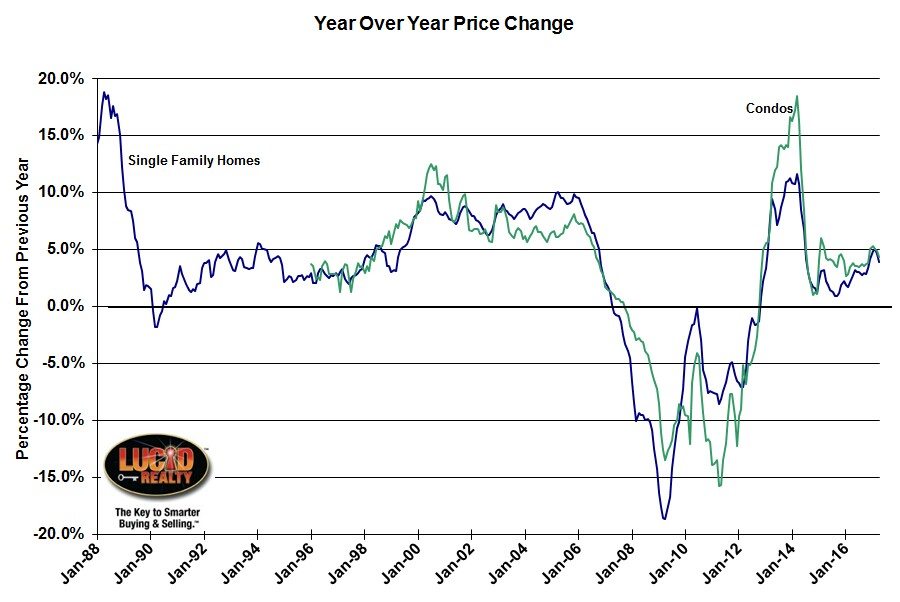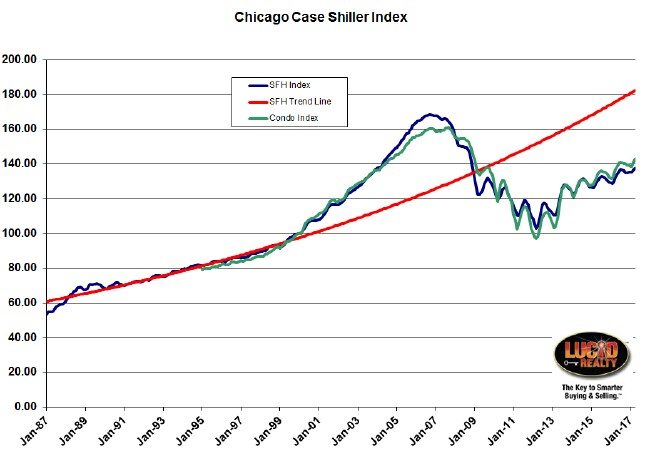When the 20 metro areas covered by Case Shiller average a 5.7% year over year gain in single family home prices it’s pretty sad when the Chicago area can only eke out a 4% gain. That’s the lowest year over year gain in 5 months and once again Chicago finds itself 4th from the bottom in the ranking of the metro areas. That’s my takeaway from this morning’s release of the April Case Shiller home price index.
Of course, 4% is probably higher than the vast majority of homeowners’ mortgage interest rates – i.e. they are making money on owning the house. But, hey, what’s holding us back? I won’t go there.
Condo prices in the Chicago area did a bit better on a year over year basis with a 4.4% gain, but that’s also the lowest gain in 5 months. I’ve got the graph of the history of these year over year gains for both types of housing below.

As home prices continue rising faster than inflation, two questions are being asked: why? And, could this be a bubble? Since demand is exceeding supply and financing is available, there is nothing right now to keep prices from going up. The increase in real, or inflation-adjusted, home prices in the last three years shows that demand is rising. At the same time, the supply of homes for sale has barely kept pace with demand and the inventory of new or existing homes for sale shrunk down to only a four- month supply. Adding to price pressures, mortgage rates remain close to 4% and affordability is not a significant issue.
The question is not if home prices can climb without any limit; they can’t. Rather, will home price gains gently slow or will they crash and take the economy down with them? For the moment, conditions appear favorable for avoiding a crash. Housing starts are trending higher and rising prices may encourage some homeowners to sell. Moreover, mortgage default rates are low and household debt levels are manageable. Total mortgage debt outstanding is $14.4 trillion, about $400 billion below the record set in 2008. Any increase in mortgage interest rates would dampen demand. Household finances should be able to weather a fairly large price drop.
Case Shiller Chicago Home Price Index By Month
From March single family home prices in the Chicago area rose by 1.0%, which I should remind you is largely a seasonal effect. Condo prices were up by 1.3% from March. The long term graphs of the monthly numbers are shown below.
The Case Shiller national home price index set another record for the fifth consecutive month but as you can clearly see in the graph below the Chicago area has not even recovered to peak levels. In fact, we are still 18.3% below the peak in single family home prices while condo prices are still 11.3% below their peak. In addition, single family home prices are lower than they were during the entire period from January 2004 – December 2008 while condo prices are lower than they were from September 2004 – January 2009.
Furthermore, if you look at the red trendline below you will see we still have quite a gap from where we would have theoretically been if we had continued at the pace prior to the whole housing bubble fiasco. That is a 24.5% gap.
Nevertheless, the good news is that we’ve come a long way from the bottom. Single family home prices are up 34.1% while condo prices have recovered by 46.9%.
#ChicagoHomePrices #CaseShiller
Gary Lucido is the President of Lucid Realty, the Chicago area’s full service discount real estate brokerage. If you want to keep up to date on the Chicago real estate market, get an insider’s view of the seamy underbelly of the real estate industry, or you just think he’s the next Kurt Vonnegut you can Subscribe to Getting Real by Email using the form below. Please be sure to verify your email address when you receive the verification notice.
